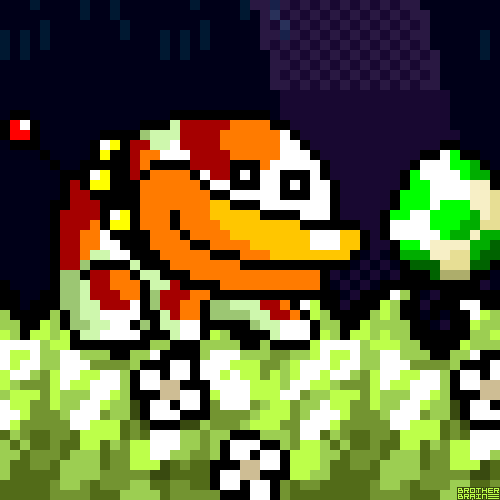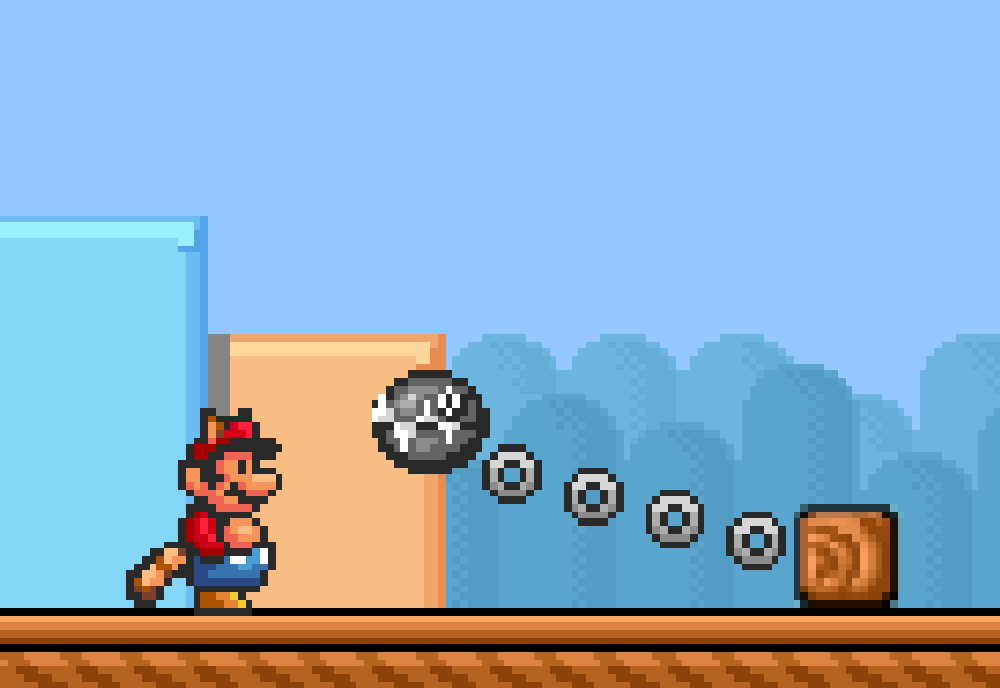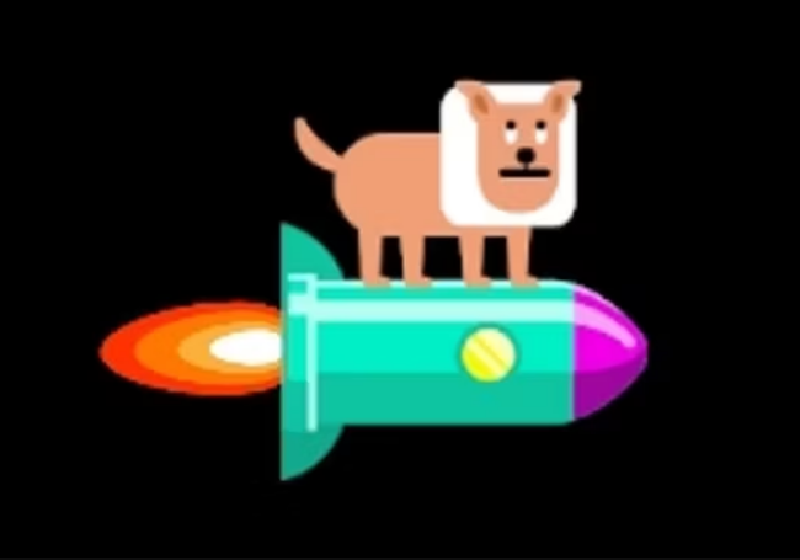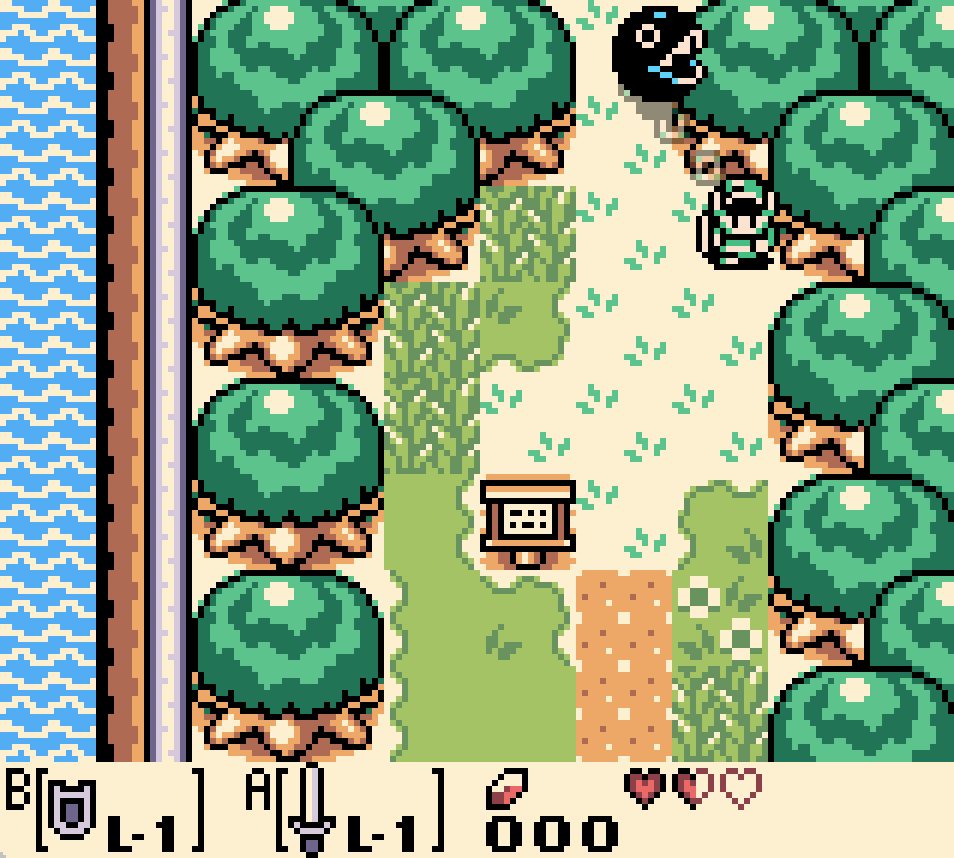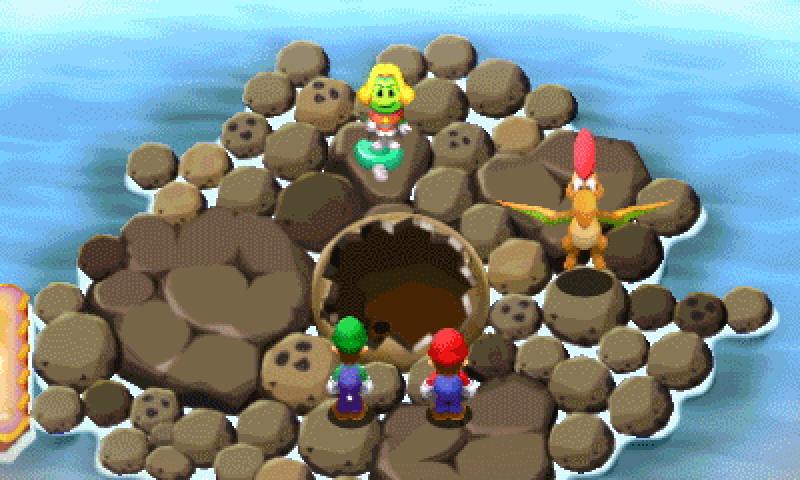Dogs, Popeye and the Super Mario Bros. Anime
If we’re having a discussion about dogs in the Mario series, then I guess it should begin with Poochy, the noseless dog who debuted in Yoshi’s Island and has since become a recurring canine buddy.
Via Brother Brain.
But if not Poochy, then the next candidate would probably be the Chain Chomp, the recurring enemy that debuted in Super Mario Bros. 3. Despite essentially being a bowling ball with teeth, the Chain Chomp was allegedly inspired by a real-life incident in which a young Shigeru Miyamoto was charged by an angry dog. He wasn’t bitten because the dog was chained, and just before the dog could reach him, the chain pulled tight. In Japan, the Chain Chomp has always been Wanwan (ワンワン), from the onomatopoeia for the sound of a dog barking, so it would have been clear from its first appearance that it was supposed to be dog-like. Outside Japan, the association only became clear in Super Mario 64, when they barked like dogs. Wan wan!
Beyond that? Well, there is Undodog, the Mario Paint refugee who began as the in-game equivalent of CTRL+Z and now lives on in the Mario Maker games as a full-on character.
The Luigi’s Mansion games have the Polterpups, very cute and very undead dogs that Luigi meets as he ventures through various haunted houses.
And then there is Belome, the four-eyed sewer boss from Super Mario RPG. He has since been relegated to the limbo inhabited by all the weirdos created for this game. I’d like to think they’ve been building a sort of human pyramid since 1996 that has just recently reached high enough that Geno has been able to crawl out.
However, there is one more dog of note in the extended Marioverse, though he’s never appeared in a game, and I’m bringing him up because of a possible connection to Popeye. Yes, all that history of Super Mario dogs was just a preface for what is essentially a follow-up to my post about Popeye’s lesser-known video game legacies.
The hourlong anime Super Mario Bros.: The Great Mission to Rescue Princess Peach was released in theaters in Japan on July 20, 1986, just ten months after the video game Super Mario Bros. first hit shelves. As a result of the source material being rather limited, the film uses every scrap it can from that first game — and when that isn’t enough, it introduces several new characters, including Kibidango, a teal dog that initially steals Peach’s brooch but then later accompanies the brothers on their quest through the Mushroom Kingdom.
What’s interesting about Kibidango’s design is that he looks peculiarly like a character from Popeye comics and cartoons: Eugene the Jeep, who is not a dog, but who kind of looks like one and who is regarded by characters as being very dog-like, even though it is actually an extradimensional being that has teleportation powers.
There is a Popeye strip that ran on August 9, 1936, in which Popeye asked the Professor Brainstine character what a Jeep is. The answer does not explain anything. That’s the joke.
The Popeye “Wha’s a Jeep” cartoon from August 9, 1936.
I hadn’t connected the two until Teslagrad art director Ole Ivar Rudi pointed out in this tweet that Kibidango and Eugene the Jeep look a lot alike. (The neat thing about publishing a post like the Popeye one is that moving forward, if anything ever happens that puts Popeye in the context of video games, someone will tell me about it — and sometimes it even leads to something interesting, like this one did.)
They do look alike, I agree. I hadn’t thought about this when I was writing my big Popeye post, but yeah, now that you mention it, looking at Kibidango, I do think that’s a really weird way to draw a dog if you’re not intentionally trying to evoke the Jeeps from Popeye. And it’s not like Kibidango’s design fits especially well with all the anime’s version of the generic Super Mario Bros. enemy creatures either.
So is the connection intentional? I don’t know, but let me lay some research on you so you can decide for yourself.
As I explained in the earlier post, Popeye was extremely popular in Japan, to the point that characters from this franchise sometimes showed up in weird places decades later. Beyond that, the Jeep itself also proved very successful, with multiple sources identifying it as a mascot for the series, though I have to wonder why the mascot for the Popeye comics wasn’t just Popeye himself.
One example of the Jeep perhaps having some reach beyond Popeye media is its presence in the debate over the etymology of the word jeep, referring to the utility vehicle. Now, the source I trust most for etymologies is Etymonline, as it offers up clear, concise explanations of where words come from. According to Etymonline, the earliest recorded use of jeep the way we use it now was in 1941, as a slang abbreviation by American military folk for the original name for this kind of vehicle: general purpose, or G.P. However, Etymonline also says that the term was “certainly influenced” by Eugene the Jeep. It doesn’t explain why, but other, less concise discussions of the term link Eugene the Jeep’s ability to teleport — to go places it shouldn’t be able to go — with the vehicle’s ability to drive in difficult terrain. Some people point to the word jeep being used in various military contexts, vehicular and otherwise, going back to World War I. If that’s true, it wouldn’t invalidate G.P. abbreviating down to just jeep and also that the reputation of this Popeye character made it a name that people liked and understood.
To sum up, we don’t know how much Eugene the Jeep helped create the term jeep, but he does show up in every discussion of this matter, and given the fact that the original comics give him the ability to pop up in places where he’s not expected to be, that is perhaps thematically appropriate even if it doesn’t get us to a solid answer.
I looked around to see if other people had made a connection between Kibidango and Eugene the Jeep. As near as I can tell, it’s not; Ole Ivar Rudi might be the first person to make this connection and point it out online. However, in looking, I did pull up some references to a 1943 Japanese war propaganda film I mentioned in the original Popeye post: Momotarō’s Sea Eagles, which serves as a sort of response to an American cartoon that showed Popeye sinking the Japanese navy. In this film, the Japanese military is represented by cute animals led by Momotarō, the hero from Japanese folklore. According to Richard M. Davis’s 2019 paper examining how World War II-era cartoons map onto Japan’s imperial ambitions, there is a scene in Momotau’s Sea Eagles in which a monkey airman eats a food item in a way that parodies Popeye eating his spinach.
You can see this sequence in the video below at the 16:16 mark.
This is interesting for a few reasons. First, the name for those round dumplings the monkey eats is kibi dango (黍団子). Not to be confused with the similar-sounding Kibi dango (吉備団子), a sweet associated with the Kibi province, kibi dango are dumplings made from the grain of proso millet — or kibi. Per the legend, they’re also the food Momotarō gives to his animal friends to earn their friendship.
When you look at the way the boulettes look like stacked on a stick, the way the monkey eats them in the propaganda film, they actually look a lot like Kibidango the Mario anime character, who is essentially just a series of spheres stacked end to end. And that makes me think that the dog is just named after and designed to look like the food item.
Beyond that, there’s a surprise at the end of the film that makes me think Kibidango is drawing from the Momotarō legend. Once King Koopa is beaten, it’s revealed that Kibidango is actually Prince Haru, Peach’s male counterpart from nearby Flower Kingdom and the owner of brooch that matches hers exactly. As he explains to Mario and Luigi, he’d been transformed by King Koopa when he ventured to the Mushroom Kingdom looking for the woman destined to become wife, and the story ends with Mario and Luigi leaving the Mushroom Kingdom and the happy couple.
I suppose it’s possible that Kibidango’s name is a hint that there’s a connection to the princess, since Momotarō (桃太郎) literally means “peach boy” and kibi dango is something strongly associated with the character. Haru is essentially a male version of Peach; he’s not literally a peach boy, but he’s pretty close to a being a boy Peach. But I suppose it’s also possible that Kibidango was just named after food like so many characters in manga and anime are. Haru’s name just means “spring,” which is appropriate enough for the prince of a place associated with flowers.
Does this mean that Eugene the Jeep wasn’t a visual inspiration for Kibidango? No. As I explained with the etymology of jeep, there can be a perfectly straightforward explanation for how we got that word, but that doesn’t mean this Popeye character didn’t factor in as well. So it’s possible that Kibidango is an homage to the Popeye character; I just can’t find any proof of it. As is often the case, writing about something like this is often a handy means for getting more information to come to you — that is how this post came about, I will remind you — and if I find anything, I will update this post.
Once again, Eugene the Jeep is famously good at showing up places where you wouldn’t expect him to be, so he may have a Mario connection after all.
Miscellaneous Notes
As with many origin stories of video game characters and concepts, the one about Chain Comp being inspired by young Shigeru Miyamoto’s encounter with a dog is often repeated, though I’m not sure what the initial source of it is. Several wikis cite this 2010 Guardian listicle of zany Mario facts, which does not cite sources. Others cite David Sheff’s Game Over, which does mention this backstory indirectly, while describing the various ways Miyamoto’s childhood resulted in video game elements. It reads,
The Miyamoto family had no television and no car. Every few months they traveled by train to Kyoto to shop and see movies: Peter Pan, Snow White. At home, Miyamoto lived in books, and he drew and painted and made elaborate puppets, which he presented in fanciful shows. After school, he often lit out into the countryside for adventure. He had to pass a neighbor's house where a bulldog lay in wait for him. The dog charged every time, barking and snapping, and Miyamoto froze. At the last second, the dog's chain reached its limit and jerked it back. Miyamoto stood just out of the reach of its salivating jaws.
Investigating hillsides and creek beds and small canyons, Miyamoto once discovered the opening of a cave. He returned to it several times before he worked up the courage to go in. Lugging a homemade lantern, he went deep inside until he came to a small hole that led to another cave.
Which is interesting in that it doesn’t mentioned the phrase “Chain Chomp” at all, but also this passage seems more like a collection of Miyamoto anecdotes more than anything else. I assume they are ones that Miyamoto related to Sheff during interviews, but they might also be a mix of those and stories that came from elsewhere. Game Over offers a selected bibliography that doesn’t do much to explain what facts came from where, and Sheff’s 1992 Rolling Stone profile on Miyamoto doesn’t mention the story about the dog. Presumably, the first mention of the origin of the Chain Chomp came from somewhere else. Perhaps it was in Nintendo Power’s coverage of Super Mario Bros. 3? If anyone reading this knows, please tell me.
Although it wasn’t clear in English localizations that Chain Chomp was supposed to be a dog until he barked in Super Mario 64, people who played Legend of Zelda: Link’s Awakening got a tip-off in Bowwow, a Chain Chomp that characters in the game treat as if we were just a dog. For what it’s worth, Chain Chomps first appeared in the Zelda series in the Turtle Rock dungeon of A Link to the Past. Zelda does have a history of crossovers going back to the first game, after all.
Speaking of which, there seems to have been a point in the production of A Link to the Past when the Chain Chomp enemies where known as ケルビン or Kerubin. Maybe Kelvin? And the sources all point back to this Glitterberri-translated interview, but I can’t find any explanation for it. Do you know? Will you tell me? Please do!
I mentioned in my compilation of all the ways Super Mario Bros. 2 shaped later Mario games that the Japanese sequel to Super Mario Bros. 2, the game we call The Lost Levels in the U.S., is the game that solidified Princess Peach’s look. In the Japanese art for the first Super Mario Bros, she looked more like a kid wearing pink jammies. From The Lost Levels on, she looks essentially how she looks today. The anime, which debuted the month after The Lost Levels, also features that new look, and I am curious to know if the people making the anime designed their take on Peach based on what Nintendo was cooking up for the sequel or if the anime, which would have had to go into production very shortly after the first Super Mario Bros. was released, might have influenced Nintendo to adopt a new look for the character.
Along similar lines, I’ve dug the design of Prince Haru ever since I first saw the Mario anime, and I wish there had been a place for him in the Mario games. The fact that there’s not probably is a result of the same factors that prevent Imajin and the rest of the Doki Doki Panic characters from showing up in any later Nintendo games. Fuji owns them, and I’d guess that the producers of the anime, Grouper Productions, owns the rights to Prince Haru. The closest the series has ever come to a dashing prince type is either Prince Pine from Yoshi’s Safari, a sort of male damsel in distress that you rescue after you rescue Peach.
He’s… not a princely dreamboat like Haru is, but he is as close as Nintendo has ever offered to an in-game male counterpart to Peach. His name hints at this, though again it’s harder to spot in English. In Japanese, it’s パイン王子 (Pain-ōji), and it would seem to be derived from パイナップル (painappuru) or “pineapple.” This also might explain why he looks weird, as he is designed to kinda sorta look like a pineapple. And the kingdom he’s given as his place of origin is Jewelry Land, which probably isn’t a reference to Haru’s brooch… but you know, also it might be.
I suppose we could also nominate Prince Peasley from Mario & Luigi: Superstar Saga, though notably he seems more interested in making flashy appearances than he does anything else, including making Peach his bride. Just saying.
Finally, there is a more direct collision of Mario and the Momotarō tale in the *other* Mario anime, Amada Anime Series: Super Mario Bros., which casts the characters in various folktales. One of them has Mario playing Momotarō. And you can watch the entire clip below.


